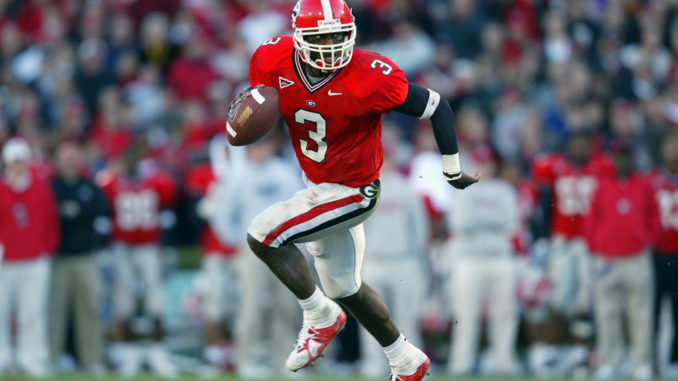
According to most reports, it seems UGA will open the 2016 season with true freshman Jacob Eason as its starting quarterback. This isn’t particularly surprising. He’s a blue chip prospect, and there’s a new coaching staff in place that has enough goodwill and patience to withstand the bumps in the road that come from playing for the future. And while Eason may or may not be good in the present, getting the passer experience now will certainly bode well for his future.
But what of the present? What sort of career do 5-star prospects have? Are they better equipped than most true freshmen to handle starting duties? Let’s run through a history of similarly lauded quarterbacks. 247’s Composite rankings have individual player star rankings going back to 2000, so that seems as good a place as any to start (beginning in 2001, they separated qbs as pro-style or dual threat). Part 1 will cover those in recruiting classes from 2000-2003.
2000
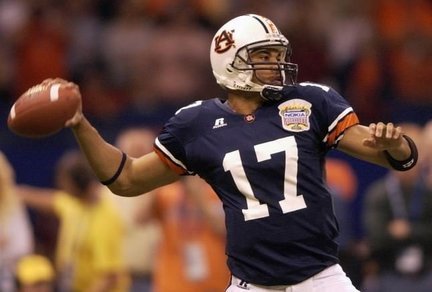
Brock Berlin, Florida
Year 1: Berlin played sparingly, attempting 27 passes in 4 games. 19 of those passes came in a 47-35 loss against Mississippi State, where he played it safe for the most part, picking up 2 TDs to no INTs, but averaging just over 5 yards per dropback.
After that: Steve Spurrier mostly burned Berlin’s sophomore year as well, allowing him to top 10 passes only twice, both in garbage time of blowouts. After the season he transferred to Miami, where he was a pretty bad starter for the ’03 Canes, a team that managed to win in spite of him, and a pretty good starter for the ’04 team, which didn’t win quite as much. He would go undrafted, but hang around the NFL a few years, eventually playing in two games for the Rams in 2007-2008.
Jason Campbell, Auburn
Year 1: Redshirted
After that: Campbell may be best remembered as a game manager of sorts who captained the ’04 undefeated Tigers, but he was a pretty solid passer all four years in Auburn. He wasn’t great until his senior year, but he was always pretty good. In ’01, he averaged 6.3 yards per play. In ’02, 6.4. Then 6.2 in his first year as full-time starter in ’03 and finally peaking with 8.3 yards per play in ’04, when he finished 4th nationally in ESPN’s adjusted-for-context QBR metric at 83.3. Campbell was a first round draft pick in ’05, has played in 90 NFL games, and put together a not-bad but not spectacular pro career.
Casey Clausen, Tennessee
Year 1: 9 games, 121/194, 62.4%, 1473 yds, 15 TD, 6 INT; 40 “carries” for -42 yards – . Tennessee wasn’t supposed to see Clausen much that year. Former highly touted recruit AJ Suggs was the penciled-in starter, with the possibility of sharing time with Joey Matthews. But against Southern Miss in the opener, neither could really get going. Matthews dropped back 17 times and had 43 yards to show for it. Suggs picked up 75 yards on 9 plays, but Tennessee struggled to a 19-16 win in which they were outgained and mostly outplayed. Suggs played the entirety of game 2, the annual September rivalry game against Florida, and the game was a classic. I’ll defer to the description posted by Alligator Army, SB Nation’s UF site:
Florida and Tennessee both came into this game ranked slightly lower than usual, but with all the heartbreaking moments endured by both in recent years (Peyton’s fourth loss to Florida in 1997, Florida’s OT loss in 1998), the game took on a huge role. On this day, Tennessee was plagued by a hilarious (for Florida fans, anyway) inability to finish drives. The result was five Alex Walls field goals, and a 23-20 Tennessee lead late in the fourth quarter. Note to Tennessee fans: if you finish off just two of those five drives for touchdowns, the score is 31-20, and the agonizing finish to the game I’m about to describe never would have happened.
With 2:14 to go and down three, Florida was backed up to its own 8 yard line. Jesse Palmer then proceeded to lead one of the greatest drives in Gator history, capped by one of the most egregiously blown calls I have ever seen. Palmer flung a laser to Jabar Gaffney, who briefly touched the ball with both hands and then had it knocked out. The ref signaled touchdown while the ball bounced around on the turf.
Here’s the problem with Vols fans saying that call cost them the game: that pass was on second down with 14 seconds left. The Gators would have still had a third down play, and had that failed, they would have gone for a chip shot field goal to force overtime. At worst, it cost Tennessee a shot at overtime, but there’s no telling who would have won it.
Suggs was particularly to blame for many of those drives stalling out. He gained 142 yards on 36 plays, a paltry sub-4 average. Against UL-Monroe the next week, Tennessee flexed a bit to make itself feel better, dropping 70 on the Warhawks (or whatever their name was at the time), but Suggs still didn’t look great. In the next game, a 38-31 OT loss to LSU, a quick glance at his stats might suggest improvement – he tallied 316 yards, 3 TDs, and 0 INTs – but it came on a whopping 66 plays; Suggs again averaged less than 5 yards per play and the Vols lost. Against Georgia, Suggs started miserably, picking up 82 yards on 28 (!) plays. At that point, staring a 2-3 record in the face and pretty much useless on offense (outside of RB Travis Henry), Tennessee turned to its star recruit, Clausen. He wasn’t much better against Georgia (4.4 ypp with a turnover), but he earned the starting job for the rest of the season. He wasn’t exactly a top threat behind center (6.1 ypp is ok but it’s not the production that carries the offense), but he did prove to be an improvement over Suggs, and engineered wins over rival Alabama and Vandy, winning all 6 of his starts.
After that: Clausen averaged 7.0 ypp in 2001, leading Tennessee to the SEC East Title and putting the team in position to play for the national championship. It was all undone in the SEC title game as UT was upset by LSU in what might be one of the most important football games in SEC history, at least in terms of what it meant for each team’s future trajectory. That game marked the beginning of the decline of Tennessee as a major national power, and it coincided with the rise of Saban. Clausen wasn’t to blame, though – he played well in the loss. In ’02 he regressed a bit (6.2 ypp), missing part of the year, including the UGA game, to a shoulder injury, which doubtlessly affected him in games he did manage to play. In his senior season, he was still mired in the “pretty good” range (6.1 ypp), but UT did turn to him for more scoring plays, as he had a career high 29 TDs (on a career high # of plays and the lowest completion rate of his career). Also of note – Clausen told reporters that, if allowed to play in 2002, he would’ve beaten Georgia by multiple touchdowns with only one arm at his disposal, but doctors wouldn’t allow him. Georgia generously allowed Clausen to use 2 arms in the 2003 matchup, and near the end of his career, he looked an awful lot like the man he replaced as a freshman, averaging just over 5 yards a play with more turnovers than scores in a 41-14 home loss to Georgia, one of the worst games ever witnessed by Neyland Stadium, as Clausen struggled with a trick play known in some circles as a “handoff”:
Clausen got a pro contract as a UDFA, played a little in Europe, but it never amounted to anything. He became a HS head coach in December 2013.
Chance Mock, Texas
Year 1: Redshirted
After that: As a RS Freshman and RS Sophomore, Mock sat behind the Chris Simms / Major Applewhite 2 QB system. In 2003, he was named starter for the beginning of the season. He looked like he should look in his first start, against New Mexico State, but was mediocre in a 38-28 loss to Arkansas. He played brilliantly against Rice and Tulane, because he was playing against Rice and Tulane, but averaged 2.92 yards per play against Kansas State, a game Texas won 24-20 thanks to the heroics of Mock’s backup. Facing #1 ranked Oklahoma in the Red River Rivalry Shootout, Mock was named the starter, but after the first drive was relieved by the backup, and finished the game with 25 yards on 10 plays, and Oklahoma drilled the Longhorns 65-13; after the game, Mock lost his starting duties. Mock would continue to play a bit as a secondary QB (Mack Brown still liked the 2-QB system), but he wouldn’t have 20 plays in a game again until the Holiday Bowl, where he averaged 2.9 ypp. Oof. By ’04, he had permanently lost his starting job to that former backup. That QB? Vince Young. Mock’s legacy of Texas might be that of a QB too careful for his own good – he still holds UT’s career record for lowest INT rate (0.94%). Protecting the ball is good, but protecting it by never throwing downfield and taking countless sacks isn’t. After Texas, Mock played some Arena ball and later worked for the ill-fated Triton Financial, an investment company whose CEO (not Mock) would go to prison for 17 years for fraud. He’s now an Austin real estate agent.
Jeff Smoker, Michigan State
Year 1: Smoker was the opening day starter, although fellow QB Ryan Van Dyke got considerable playing time as well. In 9 games, Smoker totaled 1360 yards on 270 plays (5.0 ypp), with 8 TDs to 7 INTs. Not awful, but not surprising for a true freshman.
After that: Smoker had a good sophomore season (2521 yards, 7.3 ypp, 23 TD, 8 INT), a decent junior year (1554 yards, 6.4 ypp, 13 TD, 10 INT) cut short by a suspension for substance abuse, and was decent again in a healthy senior year (3279 yards, 6.0 ypp, 24 TD, 14 INT). In his career, he set many Michigan State passing records, and remains the 3rd leading passer in MSU history. The Rams drafted Smoker in the 6th round, but after a year he lost his clipboard-holding spot to Ryan Fitzpatrick. Smoker bounced around a few practice squads and then wound up as a multi-year starter in the Arena League.
2001
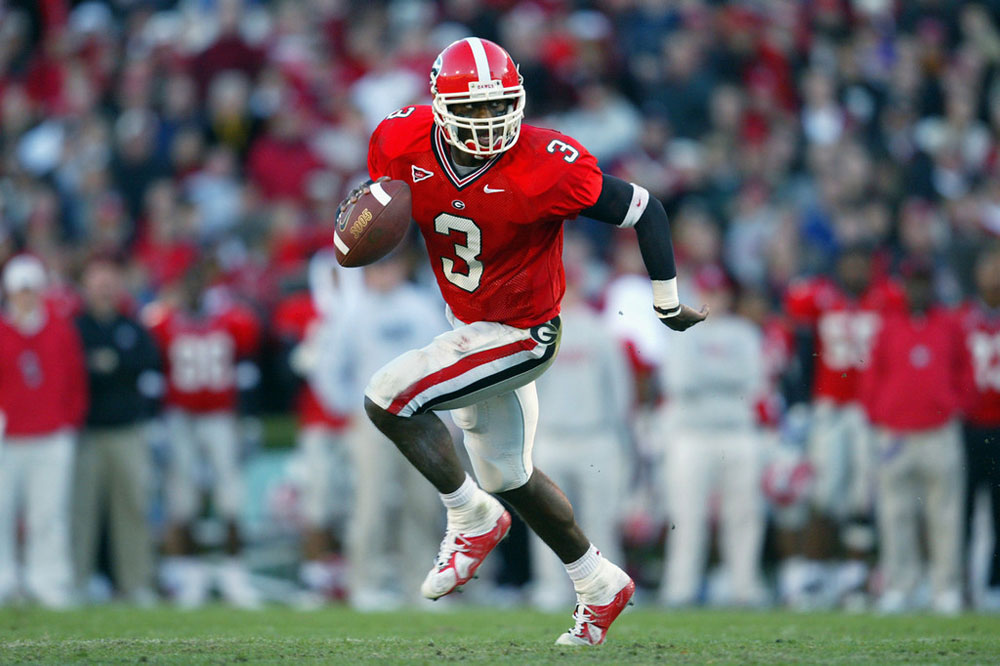
Brodie Croyle, Alabama (Pro)
Year 1: Redshirted
After that: Croyle originally seemed poised to go to Florida State, because he specifically wanted to play for FSU OC Mark Richt. When Richt took the Georgia job, Croyle fell back to his dad’s alma mater, Alabama. In 2002, after being named pre-season QB2, Croyle played extensively in a midseason win over Arkansas and the subsequent loss to Georgia, but otherwise watched Tyler Watts get the meaningful snaps. Croyle played well as a RS Freshman (6.5 ypp, 8 TD, 5 INT), and was announced as the starter for his sophomore season. In it, he was mediocre (2311 yds, 5.6 ypp, 16 TD, 13 INT) due to injuries to his shoulder and ribs. His junior year was considerably improved (507 yds, 6.8 ypp, 6 TD, 0 INT) until it was cut short by an ACL tear. As a senior, now hobbled from his recovering injury, Croyle protected the ball but wasn’t explosive or efficient with it (2343 yds, 5.8 ypp, 15 TD, 4 INT / 56.4 QBR, 48th in country), but thanks to a fantastic defense, it was enough to win 10 games. The Chiefs made him a 3rd round pick. It’s hard to classify him as anything but a bust in the NFL; the Chiefs lost all 10 games he started in his career. He’s now retired, involved in charity work that helps kids from abusive situations, and he’s married to a former beauty queen.
Cecil Howard, Syracuse (Dual)
Year 1: Redshirted
After that: During that redshirt year, he, by his own admittance, fell out of love with football and was generally unhappy. He transferred to Youngstown State, but after 6 days, he left YSU. He landed at Northeastern, where he had to sit out a year due to having transferred from another FCS program. Northeastern cut scholarships, so Howard transferred again, this time to California University of Pennsylvania. I was unable to find any record of him playing a down of college football.
Joe Mauer, Florida State (Pro)
Did not attend college, as the Minnesota Twins made him the #1 pick in the 2001 MLB draft and paid Mauer handsomely to have a great career with his hometown team.
D.J. Shockley, Georgia (Dual)
Year 1: Redshirted
After that: In 2002 (526 yds, 5.9 ypp, 7 TD, 2 INT), Shockley was an exciting change-of-pace QB off the bench for Georgia, and looked really good in his only game of extensive action against Kentucky. In ’03 (190 yds, 5.0 ypp, 2 TD, 1 INT), he again was in the same role and understandably pressed a bit when he saw action, often attempting to do too much given his opportunities. In ’04 (577 yds, 6.9 ypp, 4 TD, 1 INT), he emerged as more of a threat, albeit one still coming off the bench behind David Greene. For the most part, that decision was justified – Greene was excellent as well – but head coach Mark Richt famously stuck with a struggling Greene against Tennessee when Shockley was giving the Vols fits, a game UGA might not have lost 19-14 had Shockley seen the field more. In 2005 (2910 yds, 7.5 ypp, 28 TD, 5 INT), with Greene graduated and out of the picture, Shockley had a brilliant season, leading Georgia to its most recent SEC Championship. By QBR, he was the 9th best QB in the country, and were it not for historic seasons by players from USC and Texas, Shockley might have been a Heisman finalist. He was a 7th round draft pick of the Atlanta Falcons, where he hung around on and off the scout team for 5 years or so. He moved on to the United Football League, and has since been involved in broadcasting and studio work surrounding the Falcons.
2002
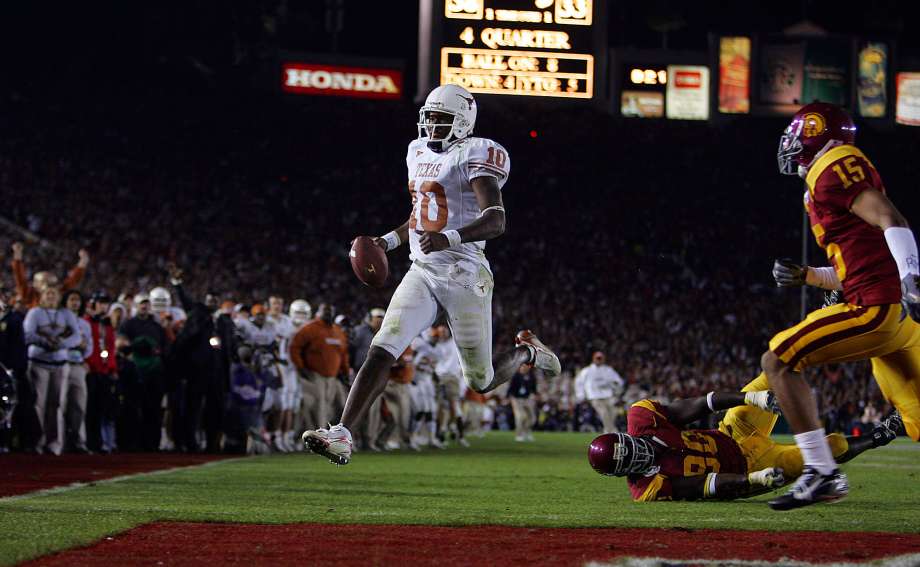
James Banks, Tennessee (Dual)
Year 1: 340 yards, 4.8 ypp, 2 TD, 0 INT. His only meaningful action was in the loss to Georgia, filling in for the injured Casey Clausen.
After that: Banks was moved to WR in 2003 (636 yds, 14.5 ypc, 7 TD), but would last only the one year. After 4 suspensions of varying degrees, Tennessee ultimately kicked him off the team. He resurfaced at Carson-Newman but I was unable to find evidence of him playing games there.
Trent Edwards, Stanford (Pro)
Year 1: Redshirted
After that: Got into 8 games as a RS Freshman in 2003 (727 yds, 3.7 ypp, 5 TD, 9 INT), but was mostly ineffective. He earned the starting job as a RS Sophomore in 2004 (1744 yds, 5.3 ypp, 10 TD, 11 INT), but lost parts or all of 4 games to injury, and there’s no telling how it affected his other numbers. He had a healthy, full season as a Junior in 2005 (2087 yds, 5.9 ypp, 17 TD, 7 INT / 60.2 QBR, 40th nationally), and was very productive, especially when you consider what Stanford’s talent level looked like in the pre-Harbaugh years. He started the first 7 games of his senior year in 2006 (1064 yds, 4.9 ypp, 6 TD / 6 INT) but was lost for the year with a broken foot after that. Edwards was drafted in the 3rd round by Buffalo, and he had a couple of encouraging, if not particularly effective, seasons there. He bounced around the league a bit in backup roles and was last threw an NFL pass in 2012.
Reggie McNeal, Texas A&M (Ath)
Year 1: 593 yds, 7.2 ypp, 6 TD, 3 INT. Over most of his Freshman year, McNeal played sparingly if at all. Through November 2, he had only tallied 10 plays once, a miserable 12 plays, 12 yards showing against Virginia Tech. On November 9, facing the #1-ranked Oklahoma Sooners, starting Aggie QB Dustin Long struggled to 39 yards and a turnover on 10 plays, so A&M turned to McNeal. He was brilliant in relief, passing for 191 on 13 attempts (14.7 ypa is huge), rushing for 89 on 16 (5.6), and tallying 4 TDs to a single turnover. He led A&M back for a shocking 30-26 win over the nation’s top team, earning the starting job in the process. It didn’t last long. 8 plays into the next game vs Missouri, McNeal sprained his ankle, ending his season.
After that: McNeal started the rest of his career when healthy. In 2003 (2152 yds, 6.2 ypp, 12 TD, 7 INT) he was effective, but the team went 4-8 behind one of the worst defenses in the country. In 2004 (3509 yds, 7.1 ypp, 22 TD, 4 INT) he was outstanding, setting what was at the time the A&M record for yards in a season, and by QBR (67.9) he was the 14th best QB in the country. In his Senior season in 2005 (2627 yds, 7.3 ypp, 19 TD, 9 INT), he was again excellent, but missed time near the end of the year with injuries. Worst of all, one game he missed was Texas, which would’ve been a chance to go up against his in-state rival dual threat star, Vince Young. The Bengals drafted McNeal as a WR in the 6th round, and while active for 7 games, only accumulated stats on 1 play in his NFL career – he lined up as QB on 3rd-and-7 and scrambled 8 yards for a first down. McNeal then moved to the Canadian Football League, last playing there in 2012.
Ben Olson, BYU (Pro)
Year 1: Redshirted
After that: Olson completed his two-year mission over the 2003 and 2004 seasons, and by the time he was ready to begin his college football career, he transferred to UCLA, and as a RS Freshman attempted just 4 passes. He started 6 games as a Sophomore in 2006 (791 yds, 5.4 ypp, 5 TD, 5 INT), but as his 35.5 QBR attests, he wasn’t particularly effective. An injury gave away his starting position, which he didn’t regain. In spring practice, Olson was named starter again, but in 2007 (940 yds, 5.7 ypp, 7 TD, 6 INT / 44.9 QBR) was again plagued by injuries and played only 7 games. For 2008, Olson broke his foot in fall camp and missed his final season with yet another injury. After UCLA, Olson was undrafted and went into the private sector as a businessman.
Marcus Vick, Virginia Tech (Dual)
Year 1: Redshirted
After that: As a RS Freshman in 2003 (659 yds, 6.7 ypp, 3 TD, 5 INT), Vick played sporadically and was both explosive and error-prone. In January of 2004, Vick was arrested for providing alcohol and having sexual relations with some teenage girls, one of which was 15. In summer 2004, Vick was arrested again, this time for reckless driving and possession of marijuana. As a result, VT suspended him for the 2004 season, voiding his Sophomore season. He returned to the field as the primary starter for his Junior year in 2005 (2773 yds, 6.4 ypp, 23 TD, 10 INT), and his 69.1 QBR ranked 21st in the country. He was effective, but the year was marred by more controversy, as he flipped the bird to West Virginia fans, was arrested for speeding on a suspended license, and stomped on Elvis Dumervil’s leg during the bowl game. His VT career was appropriately canceled at that point, as the Hokies threw him off the team. Vick went undrafted, and signed with the Dolphins. He got onto the field in one game as a WR and caught zero passes. His post-collegiate legal troubles have been so lengthy I won’t get into listing them. Vick has served time within the last month.
Vince Young, Texas (Dual)
Year 1: Redshirted
After that: If you read the Chance Mock section, you know how Young came to play as a RS Freshman in 2003 (2153 yds, 7.7 ypp, 17 TD, 7 INT), and he was very impressive from the beginning. As a Sophomore in 2004 (2928 yds, 7.0 ypp, 26 TD, 11 INT), he was still very good, posting a 74.3 QBR, 11th best in the country. You should be familiar with his Junior year of 2005 (4086 yds, 8.5 ypp, 38 TD, 10 INT / 86.1 QBR, 2nd nationally), when he finished his career with possibly the best game in college football history. In ’05 he became the first player in FBS history with over 3000 passing and 1000 rushing yards in a single season. He was the only player to rush for 200 yards in a BCS championship game. Drafted 3rd overall by the Titans, Young was pretty below average every year he started, but he got Tennessee to the playoffs as a rookie thanks to a good supporting cast. He popped up in the news late in his career when he went bankrupt partially due to those tasty treats served at the Cheesecake Factory. He retired in 2014 and now works at the University of Texas in a non-football role.
Justin Zwick, Ohio State (Pro)
Year 1: Redshirted
After that: As a RS Freshman, he was only involved in 10 plays. In his Sophomore year of 2004 (1241 yds, 5.5 ypp, 6 TD / 6 INT), Zwick was a mediocre QB (48.8 QBR) through his first 6 starts, but an injury opened the door for backup Troy Smith to take the starting job. Zwick regained that starting position to begin his Junior year in 2005 (384 yds, 5.5 ypp, 1 TD / 1 INT), but after a week 2 loss to Texas, Smith was named the full-time starter. Zwick would stick with Ohio State through his Senior year in a backup role. He was signed as a UDFA by the Panthers but never made it onto the active roster. He made an attempt at the Arena League but found little success there either, although he did complete the only pass attempt of his AFL career for a 47 yard TD.
2003
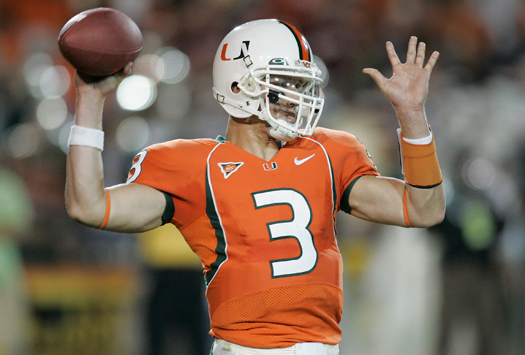
Robert Lane, Ole Miss (Dual)
Year 1: Redshirted
After that: As a RS Freshman in 2004 (551 yds, 4.7 ypp, 4 TD, 3 INT, 33.0 QBR), Lane ran more than he threw and was mostly inefficient in part-time duty. He was helpful on the run, and more at home doing it, but it was bad when he threw. The playing time was harder to come by as a Sophomore in 2005 (269 yds, 5.6 ypp, 1 TD, 4 INT, 0.9 QBR), and for good reason – of 220 FBS quarterbacks that year, Robert Lane finished 219th in QBR. Most of the yardage gained came from rushing or receptions, as Ole Miss found ways to get the ball in his hands in a non-passing role. Over his final two seasons, Lane played exclusively as a tight end.
Chris Leak, Florida (Pro)
Year 1: (2412 yds, 6.2 ypp, 18 TD, 11 INT) Ingle Martin began the year as starter with Leak as the primary backup, and he attempted 14 passes in the opening blowout win over San Jose State. Martin outplayed him in losses to Miami and Tennessee, but Leak was named starter after that. He generally played well for a Freshman.
After that: His Sophomore year in 2004 (3275 yds, 7.1 ypp, 31 TD, 12 INT / 65.5 QBR) was his most prolific, but Florida went just 7-5 in Ron Zook’s final year. For 2005 (2720 yds, 5.7 ypp, 26 TD, 6 INT / 63.0 QBR), Leak worked to cut down on turnovers, but the extra carefulness made him less explosive, and as QBR shows, he didn’t manage to trade that explosiveness for better efficiency. Adjusting to a new system may have held back his production a bit. As a Senior in 2006 (2972 yds, 6.7 ypp, 26 TD, 13 INT / 65.1 QBR), Leak was as efficient as he ever was, but he regained a bit of that explosiveness that 2005 had seen disappear, thanks to both experience in Urban Meyer’s system and the presence of two Urban Meyer’s insanely good recruiting classes. Florida didn’t require a huge leap forward anyway, as the ’06 Gator D carried the squad to the BCS National Championship. He signed with the Bears as a UDFA after the draft, but it didn’t stick, and his NFL career gained little traction. He attempted to play in the All-American Football League, but that league folded quickly. He then headed to the Canadian Football League, where he won a Grey Cup as a backup. In 2011 he moved on to the Arena League and spent a couple of years there. After his playing career, he has dabbled in radio and moved into a coaching career, first on Will Muschamp’s Florida staff, later in a front office role for the Tampa Bay Buccaneers, and is now beginning his first year as HC of Edgewater HS in Orlando, FL.
Kyle Wright, Miami (Pro)
Year 1: Redshirted
After that: Wright was involved in just 16 plays as a RS Freshman, and lost more yards via sacks than he gained via passes. Named the starter as a Sophomore in 2005 (2302 yds, 6.2 ypp, 19 TD, 10 INT / 59.1 QBR), Wright had an encouraging season, showing a nice mix of efficiency and explosiveness. The following offseason, Wright landed on watch lists and was considered a potential Heisman candidate. In his 2006 (1634 yds, 5.5 ypp, 8 TD, 7 INT / 42.8 QBR) season, he regressed in every way (the entire Miami team did, for the most part) and suffered a thumb injury late in the year, losing his starting job to Kirby Freeman. New HC Randy Shannon made Freeman the starter again the following year, but Wright reclaimed the job after a slow start for the offense, and he spent most of 2007 (1813 yds, 5.5 ypp, 15 TD, 14 INT / 39.0 QBR) as the starter, albeit a disappointingly ineffective one. He signed as a UDFA with the Vikings but never played in a game.
In Part 2, we’ll take a look at 5-Star QBs from 2004-2007.
Brent Blackwell
Latest posts by Brent Blackwell (see all)
- Georgia at Tennessee Preview - September 26, 2017
- Games I Care About and Why You Should Too – Week 2 - September 8, 2017
- Games I Care About and Why You Should Too: Week 1 - September 1, 2017

Leave a Reply